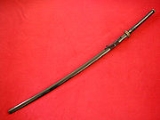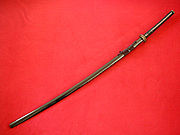
Nodachi
Encyclopedia

Odachi
An , was a type of long Japanese sword. The term nodachi, or "field sword", which refers to a different type of sword, is often mistakenly used in place of ōdachi. It is historically known as ōtachi....
meaning "large/great sword". A confusion between the terms has nearly synonymized "nodachi" with the very large "ōdachi
Odachi
An , was a type of long Japanese sword. The term nodachi, or "field sword", which refers to a different type of sword, is often mistakenly used in place of ōdachi. It is historically known as ōtachi....
". Thus, while the original use of the term may have been to refer to any type of long battlefield sword (daitō), including the tachi
Tachi
The is one type of traditional Japanese sword worn by the samurai class of feudal Japan.-History and description:With a few exceptions katana and tachi can be distinguished from each other if signed, by the location of the signature on the tang...
, it is frequently misapplied to any type of oversized Japanese sword.
History and use
Nodachi have the same general appearance and design of a tachi though they are significantly longer. They primarily were used for status symbols of either skilled duelers, a swordmaker's example of skill, dueling in general, and while thought to perhaps be used to counter cavalry Nodachi, such things were never proven. They were infrequently used for several reasons:- The blade was more difficult to forge compared to a normal-sized sword
- The nodachi required greater strength to properly wield
- Weapons such as the naginataNaginataThe naginata is one of several varieties of traditionally made Japanese blades in the form of a pole weapon. Naginata were originally used by the samurai class in feudal Japan, and naginata were also used by ashigaru and sōhei .-Description:A naginata consists of a wooden shaft with a curved...
or nagamakiNagamakiThe nagamaki is a Japanese pole weapon with a long and heavy blade with an equally long hilt, used by the samurai warriors of medieval Japan. The nagamaki is very much like the Japanese naginata or a glaive.-History:...
were more effective by far when compared to any possible use of nodachi for anti-cavalry purposes, very much like the European counterpart zweihander .
During times of peace, the sword was worn slung across the back as a symbol of status. This is distinctive because most Japanese swords such as the katana
Katana
A Japanese sword, or , is one of the traditional bladed weapons of Japan. There are several types of Japanese swords, according to size, field of application and method of manufacture.-Description:...
, wakizashi
Wakizashi
The is one of the traditional Japanese swords worn by the samurai class in feudal Japan.-Description:...
, and tachi were worn at the waist or belt; however, it was not "drawn" from the back. The nodachi was more difficult to wield due to its size and weight. The length of the nodachi's hilt varied between twelve to thirteen inches (30 to 33 centimeters). The blade was usually around four feet (122 centimeters) long. Its cutting capability and range exceeded that of a katana, due to its weight and size.
In some Chinese martial arts
Chinese martial arts
Chinese martial arts, also referred to by the Mandarin Chinese term wushu and popularly as kung fu , are a number of fighting styles that have developed over the centuries in China. These fighting styles are often classified according to common traits, identified as "families" , "sects" or...
, Bagua Zhang being perhaps the best known example, over-sized weapons are used for training purposes. This is done to condition the martial artist to handle a normal-sized weapon more efficiently (e.g. in Japanese martial arts
Japanese martial arts
Japanese martial arts refers to the enormous variety of martial arts native to Japan. At least three Japanese terms are often used interchangeably with the English phrase "Japanese martial arts": , literally meaning "martial way", , which has no perfect translation but means something like science,...
with the suburitō
Suburito
thumb|A SuburitoA is a heavier than normal wooden practice sword. In general suburitō are heavier than a standard wooden sword or an actual Japanese sword....
, a heavy wooden sword).
The Kage-ryū
Kage-ryu
is a Japanese koryu martial art founded in the late Muromachi period ca 1550 by Yamamoto Hisaya Masakatsu.The system teaches battojutsu using very long swords known as choken....
is one of the very rare schools of Japanese martial arts
Japanese martial arts
Japanese martial arts refers to the enormous variety of martial arts native to Japan. At least three Japanese terms are often used interchangeably with the English phrase "Japanese martial arts": , literally meaning "martial way", , which has no perfect translation but means something like science,...
remaining that trains in the use of the Japanese long-sword (which they call choken).
A variation of this sword was also used by Sasaki Kojirō
Sasaki Kojiro
was a prominent Japanese swordsman widely considered as a Kensei, born in Fukui Prefecture. He lived during the Sengoku and early Edo periods and is most remembered for his death while battling Miyamoto Musashi in 1612.-History:...
, a very skilled warrior and deadly with the nodachi. He is remembered principally for his duel with Miyamoto Musashi
Miyamoto Musashi
, also known as Shinmen Takezō, Miyamoto Bennosuke or, by his Buddhist name, Niten Dōraku, was a Japanese swordsman and rōnin. Musashi, as he was often simply known, became renowned through stories of his excellent swordsmanship in numerous duels, even from a very young age...
, a famed swordsman of the time.

